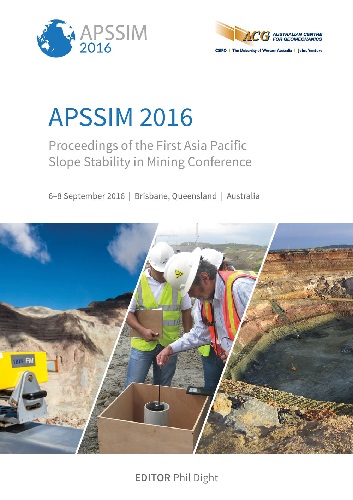Simplified Step-Path method for rock slopes

|
Authors: Baczynski, NRP |
DOI https://doi.org/10.36487/ACG_rep/1604_13_Baczynski
Cite As:
Baczynski, NRP 2016, 'Simplified Step-Path method for rock slopes', in PM Dight (ed.), APSSIM 2016: Proceedings of the First Asia Pacific Slope Stability in Mining Conference, Australian Centre for Geomechanics, Perth, pp. 255-270, https://doi.org/10.36487/ACG_rep/1604_13_Baczynski
Abstract:
Strength of most rock masses is anisotropic. This means that strength is often not uniform in all directions but depends on layering and structural fabric of the rocks. Three components of strength are rock mass, geological defects and intact rock or rock mass ‘bridges’ between defects. The Hoek–Brown criterion applies to those segments of failure path that are not co-aligned with dominant defect orientations. Conversely, the Hoek–Brown criterion is less representative where the failure path is co-aligned with such fabric. In the latter case, strength is better estimated by the Step-Path method. This approach requires slope face mapping data for several input parameters; drill core does not provide the necessary data. Conventional Step-Path methods use Monte–Carlo simulation of large numbers (> 10,000) of paths (Baczynski 2000). Any statistical model (normal, lognormal, exponential) can be considered for input parameters; many are lognormally distributed. A less rigorous Simplified Step-Path method is described in this paper. However, this approach has a limitation; statistical variability for all inputs is approximated by normal distributions. The Rosenblueth method of statistical moments, and Sampling Theory, are used to develop statistical strength models for any user-nominated Step-Path traverse length. Analysis is Excel spreadsheet based. Case study examples are presented. Step-Path computed strength may be 30 to 45% less than Hoek–Brown values. This strength reduction significantly decreases Factors of Safety and increases stability risks for rock slopes.
Keywords: jointed rock slopes, stability, failure path strength, simplified step-path, statistical approach, Monte-Carlo simulation, Rosenblueth Method of statistical moments, case studies
References:
Baczynski, NRP 2000, ‘STEPSIM4 Step-Path method for slope risks’, in GeoEng 2000: International Conference on Geotechnical and Geological Engineering, Melbourne, Australia, Vol. 2, p. 86.
Baczynski, NRP 2001, ‘Intact rock strength of Neranleigh-Fernvale strata’, Australian Geomechanics, Volume on Geotechnical Engineering & Engineering Geology of Brisbane and SE Queensland, IEAust, vol. 36, no. 3, pp. 9–15.
Baczynski, NRP 2016, ‘Step-path method: impact of defect occurrence, cut-off and length on shear strength in rock slopes’, in PM Dight (ed.), Proceedings of the First Asia Pacific Slope Stability in Mining Conference, Australian Centre for Geomechanics, Perth, in press.
Baczynski, N, Marples, R, Tamplin, S & Choros, E 2001, ‘Application of slope stability risk design process to open cut mines’, R Doyle & J Moloney (eds), in Geological Hazards – The Impact on Coal Mining, Coalfield Geology Council of New South Wales and New South Wales Department of Mineral Resources, pp. 151–171.
Barton, N 1976, ‘The shear strength of rock and rock joints’, International Journal of Rock Mechanics and Mining Sciences & Geomechanics Abstracts, vol. 13, pp. 1–24.
Bieniawski, ZT 1989, ‘Engineering rock mass classifications’, John Wiley & Sons, p. 251.
Carvalho, JL, Carter, TG & Diederichs, MS 2007, ‘An approach for prediction of strength and post yield behaviour for rock masses of low intact strength’, in Rock Mechanics: Meeting Society's Challenges and Demands, pp. 249–257.
Hoek, E & Brown, ET 1980a, ‘Empirical strength criterion for rock masses’, Journal of the Geotechnical Engineering Division, ASCE, vol. 106, no. GT9, pp. 1013–1035.
Hoek, E & Brown, ET 1980b, Underground Excavations in Rock, London Institution of Mining and Metallurgy.
Little, LN, Cortes, JP & Baczynski, NR 1999, Risk-based slope design optimisation study for the Ok Tedi copper-gold mine: Volume 5: Geotechnical models and failure modes, Internal Report dated 30 Aug 1999, Ok Tedi Mining Limited, Mine Technical Services Department, Geotechnical Engineering Section, p. 108 & Appendices A to F.
McMahon, BK 1971, ‘Statistical methods for the design of rock slopes’, in Proceedings of First Australia-New Zealand Conference on Geomechanics’, vol. 1, pp. 314–321.
McMahon, BK 1974, ‘Design of rock slopes against sliding on pre-existing fractures’, in Proceedings 3rd Congress of the International Society for Rock Mechanics, National Academy of Sciences, Washington DC, vol. IIB, pp. 803–808.
McMahon, BK 1979, ‘Report to Bougainville Copper Limited on slope design studies, Pan Hill’, McMahon Burgess & Yates, Sydney, internal report.
Read, JRL & Lye, GN 1983, ‘Pit slope design methods, Bougainville Copper Limited open cut’, in Proceedings of the 5th Congress of the International Society for Rock Mechanics, Rotterdam, Balkema, Melbourne, vol. 1, pp. C93–C98.
Rosenblueth, E 1975, ‘Point estimates for probability moments’, in Proceedings of the National Academy of Sciences, vol. 72, no. 10, pp. 3812–3814.
Rosenblueth, E 1981, ‘Two-point estimates in probabilities’, Applied Mathematical Modelling, vol. 5, no. 2, pp. 329–335.
© Copyright 2025, Australian Centre for Geomechanics (ACG), The University of Western Australia. All rights reserved.
View copyright/legal information
Please direct any queries or error reports to repository-acg@uwa.edu.au
View copyright/legal information
Please direct any queries or error reports to repository-acg@uwa.edu.au